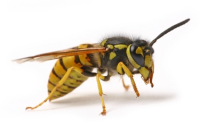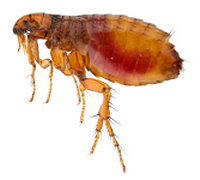Pest Control In Kent
CALL NOW - 07739 174552 (Andy)
FREEPHONE - 0800 092 9882
Mobile - 07767 875626 (Richard)
Over 30 years experience in Pest Control
We can help with all types of insect & rodent problems
Common Pests
We work in urban and countryside locations in Kent including the towns of Ashford, Maidstone, Tenterden, Tonbridge and Tunbridge Wells.
Among the most common pests we deal with are wasps, cockroaches bedbugs and rats.
Information about each of these is listed below.
Wasps

Size 12 – 20 mm
Season May – October
Habitat: Woods, hedgerows and other rough places: nests in holes, often in buildings.
The Common Wasp (V. vulgaris) is the wasp that buzzes around our food in late summer.
Look for the prominent bulge on the yellow thoracic stripe.
The face usually has three black spots, and workers and queens have four yellow spots at the rear of the thorax.
Wings are folded along the sides of the body at rest.
The queen is much bigger than the worker.
Cockroaches

Size 15 – 30 mm
Season All year
Habitat: Heated buildings, including greenhouses, and also in coal mines and sewers.
In the male the abdomen is almost entirely covered by the forewings, but in the female (above) the forewings are reduced to tiny flaps.
These cockroaches are agile and run very fast. Neither sex can fly.
This insect originally came from Asia and North Africa and is known as the black beetle or oriental cockroach.
It is basically a scavenger living on rubbish tips and buildings with a food supply.
Bedbugs

Size – Microscopic
Season All year
Habitat: The bedbug is a temporary ecto parasite of humans. When it is not feeding on our blood it hides in cracks, crevices and other harbourages in human habitation.
Their life cycle is one of incomplete metamorphosis, after mating the female lays 4-5 eggs every day
for the rest of her life, (her life span may be several weeks or even months). Eggs hatch in about 10 days at average room temperatures, more quickly at higher temperatures, yet not for several weeks at lower temperatures.
Bedbugs have five nymphal stages each are involving a blood meal, the phase lasts some six weeks, but may be longer in adverse conditions.
Bedbugs are very resistant to starvation; their faeces are often found as semi digested blood. Sometimes old nymphal skins are also found.
Common Rats

Known as Brown Rat
Season All year
Habitat: Rats have kept close to man.
Where man is, there is food and shelter whether for himself or his domestic animals. When man loads his ships with grain and other foodstuffs, rats have tended to go with them.
They even get into bales of merchandise and are conveyed in the holds of ships; or failing that, there are always mooring ropes to serve as bridges from the quay to the vessel.
The result has been that, over and above the original natural spread, rats have been carried unwittingly by man to all corners of the globe. The arrival of the common rat in this country was only one small stage in the process.


